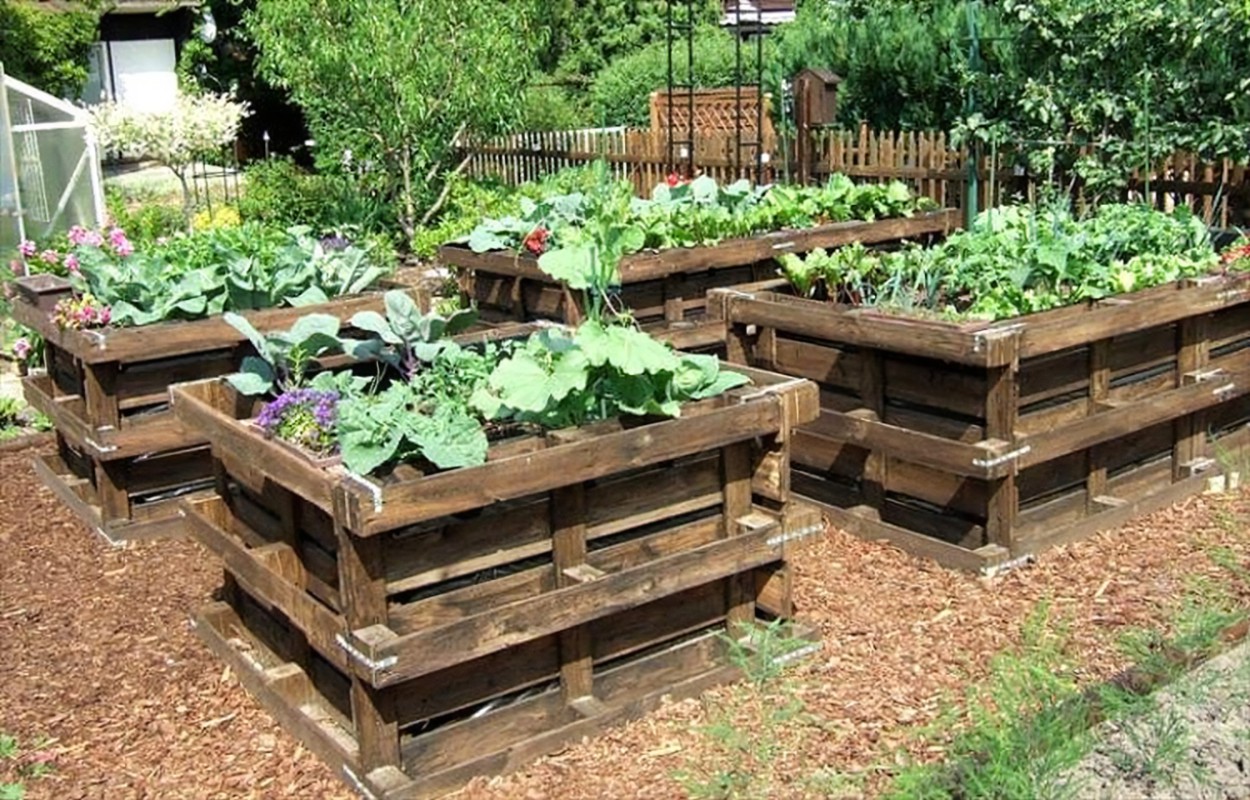Ok got the crates to the house.
Actually, their boxes, 34 inches square and 24 inches deep. They have a bottom/floor in them


What a find! I could think of so many projects to build with them just as they are.

Question.... If you cut those wrapping bands, do all the side panels and bottom come out separately? If so, lots of other possible uses for those full panels.


If you are into gardening, those pallet panels would make an excellent raised bed. I love using raised beds with the square foot gardening method.
Here is a picture of some pallet wood raised beds from Google pics....
Here is a picture of one of my (unfinished) pallet wood raised beds I made late last summer. In this picture, you see how I filled the bottom up with wood. This spring, I will be adding the 6-8 inches of topsoil/chicken run compost mix for planting. Those boards on the corners are only temporary to keep the raised beds in square when I moved them from my garage to the backyard. Some people like to add a trim board on the top edge, but I usually don't.
My pallet wood raised garden beds are 16 inches high, but that is because that is about how long the pallet slat pieces are after I cut them off the 2X4s. But I did have some old wooden fencing that was 48 inches high, and I cut them in half to 24 inches high to made some raised beds out in the main garden.

When you have raised beds that high, you don't have to bend over to maintain the plants. Much easier on my back then in ground planting, at my age.
If I had your pallet bins, I think I'd just make the garden beds 24 inches high. But you could certainly cut them down to 12 inches high (for example) and have twice as many raised beds. In either case, I highly recommend using the hügelkultur system for raised beds. That is where you fill up the bottom portion of the raised bed with wood logs, branches, wood chips, some greens, and then top it off with about 8 inches of a topsoil and chicken run compost mix 1:1.
The wood in the bottom portion obviously acts as a filler, but more importantly, the wood acts like a sponge, retaining water, and releasing it to the plants as needed. The older and more rotted the wood, the better the sponge factor. Over time, the hügelkultur bed should get better and better. Another benefit of the wood is that as it rots underneath, it turns into a rich black soil that feeds your plants even more. It's like a timed released fertilizer that works over years.
Because the wood in the hügelkultur raised beds decays, your raised bed level will fall a little bit each year. I have to top off my garden beds with maybe 2 inches of fresh compost or compost/topsoil mixture every year. But doing that also increases the natural richness of the raised bed. As the wood in the huglekulture portion breaks down and releases its nutrients into the soil underneath, your fresh compost added every year to the top also adds more nutrients. You enrich the raised bed from both the bottom and top every year. That's a really good system.

Sorry to drone on about raised beds, but this pallet wood project thread actually spun off one of the gardening threads. So, I'm a bit biased on my pallet projects. Having said that, if you are on a chicken forum, chances are you also garden and use your chicken poo to enrich your compost. If not, please consider doing it!
I have never heard of Amy pallets. It looks like a pallet with wood sidewalls. Is that what it is? What is transported in them?
Anyway, looks like a lot of wood coming your way. Have fun....

 I was going nuts trying to Google "Amy pallets" and not coming up with anything.
I was going nuts trying to Google "Amy pallets" and not coming up with anything. I think I'd lose sleep over thinking about all the projects I could build with bins like those. Nice score.
I think I'd lose sleep over thinking about all the projects I could build with bins like those. Nice score.



 When you have raised beds that high, you don't have to bend over to maintain the plants. Much easier on my back then in ground planting, at my age.
When you have raised beds that high, you don't have to bend over to maintain the plants. Much easier on my back then in ground planting, at my age. I believe all kids should feel comfortable in both the garage and the kitchen. After that, to each their own interests.
I believe all kids should feel comfortable in both the garage and the kitchen. After that, to each their own interests.
